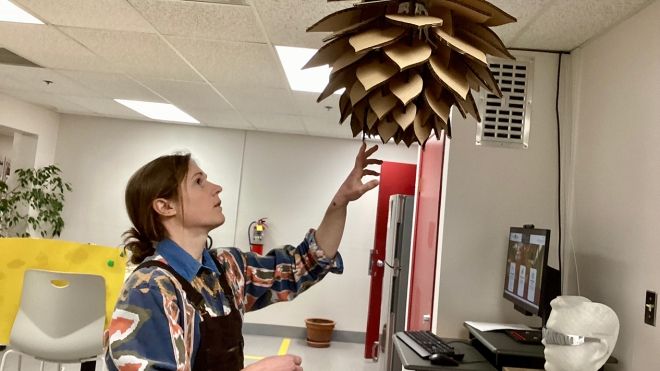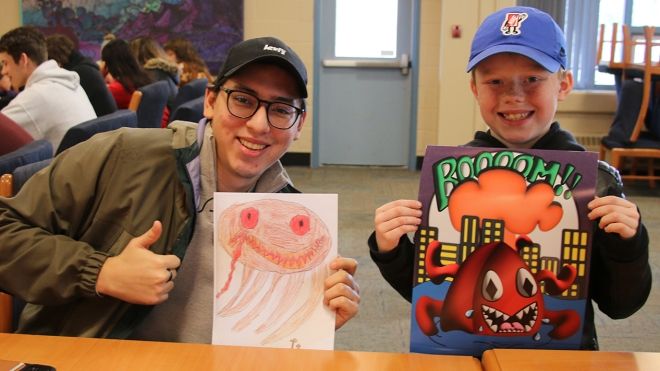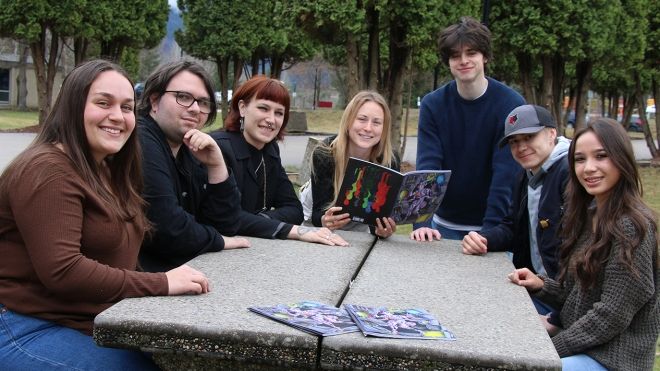Digital Arts - Diploma
Overview
Get the skills you need to take your work from the creative design process and conception to the presentation of your finished product. Launch your career in the fast-paced digital media industry.
Applying Your Knowledge
Our Digital Arts program helps you work in graphic design, illustration, animation, visual and special effects, web design, and interactive application development. Our intensive program provides you with hands-on experience in:
- Graphic Design
- Digital Photography
- Digital Video and Audio Editing
- Mobile Application Development
- Motion Graphics
- 2d and 3d Animation
- Web Design and Programming
Get a Solid Foundation
This program offers a solid foundation in traditional and graphic arts, web site development, video and sound production, animation and digital media. You will gain the skills required for advanced production techniques, effective project management and the new media business environment.
Maximize Your Employability
The program addresses rapid technological changes in the new media industry and encourages creative solutions in the production of original materials for the interactive education and training, advertising and marketing, and entertainment industries. Using skills acquired in this program, you will be able to maximize employability using a broad range of multimedia production skills. Small class sizes allow excellent accessibility to instructors and equipment.
Many graduates of this program have gone on to become professionals in the multimedia field, while others have found this program useful as a stepping-stone towards further education in the digital arts.
News
Program Outcomes
Upon successful completion of this program, students will be able to:
- Explain the foundational concepts of digital arts
- Use current industry tools and technology to produce content
- Communicate effectively and efficiently in various formats to a variety of stakeholders, consistent with industry expectations
- Apply problem-solving skills
- Adhere to best practices and professional standards within the digital arts field
- Demonstrate developing critical and creative thinking skills
- Plan and execute a creative project
Admission Requirements
In addition to meeting the general admission requirements to Selkirk College, applicants to the Digital Arts Program must meet the following requirements to be considered fully qualified:
- English 12 with a grade of 60% or higher
- Completed applicant information questionnaire
- Portfolio
Applicants must submit an electronic portfolio as part of the admissions process. An applicant's portfolio chronicles their experience and talent as an artist. The portfolio must demonstrate creativity and passion. Portfolio guidelines are found here.
In order to receive your credential in your program, you must maintain a minimum GPA of 2.00.
Courses
DA101 - Foundation of Digital Arts
DA 101 Foundation of Digital Arts. The study and profession of digital arts requires a far-reaching and comprehensive understanding of how design interfaces with technology. This course explores the language, practices and systems used in new media production. Web, print, motion graphic, video and interactive design methods are all covered in this introductory course.
DA102 - History of Art, Design and Film
DA 102 History of Art, Design and Film introduces students to major movements in art and design, and offers an overview of the century-long transition from the introduction of moving pictures to contemporary digital film making. Students explore the history of visual communication through art, design and cinema.
DA104 - Introduction to Digital Photography
DA 104 Introduction to Digital Photography provides an overview of the digital camera and related equipment, digital workflow and basic image manipulation in Adobe Photoshop. A strong emphasis is placed on how to compose compelling photographs using frame and perspective. It introduces shutter speed, aperture and exposure as a means of manipulating the creative outcome of an image. Topics also include light, depth-of-field, focal length, ISO and white balance. Students must have a digital camera with aperture (Av or A), shutter speed (Tv or S), AND manual (M) modes.
DA109 - Art Fundamentals
DA 109 Art Fundamentals is the creative process, from concept, to rough sketch, to completed artwork is the basis for the exploration of the fundamental concepts of art covered in DA 111A, Art Fundamentals. This introductory course encourages students to improve their existing drawing skills and to experiment with new methods of expression. Students work with still life and the human form to explore the fundamental tools of line, texture, pattern, form, value, depth and composition. Human anatomy and proportion are also studied. Images from art history, advertising, and contemporary media are analyzed to challenge students to see and create critically.
DA110 - Introduction To Photoshop
DA 110 Introduction to Adobe Photoshop focuses on colour correction techniques, image editing, working with layers, filters and effects, and becoming proficient with different selection tools. This course prepares learners for more advanced projects in DA 112 and DA 113.
DA112 - Digital Image Making
DA 112 Digital Image Making, introduces students to building custom digital artworks and illustrations in Adobe Photoshop and Adobe Illustrator. Students exercise their creativity and software skills to create complex artworks.
DA113 - Design Narrative
DA 113 Design Narrative. The principles of design, the functions of design, design theory, colour theory and typography are areas of study for DA 113, Intermediate Art and Design. Concepts are analyzed during lectures and discussion and are applied to projects using Adobe Illustrator.
DA121 - Introduction to Animation
DA 121 Introduction to Animation introduces a wide range of traditional animation styles and techniques including: hand drawn, puppet, pixilation, cut-out and clay animation. Students gain hands-on experience by experimenting with each animation style and incorporating the principles of animation to create a number of short animations. Students apply their knowledge of animation to create a short film using the medium of their choice. Emphasis is placed on the process of creating an animated short, which involves collaboration, brainstorming, script writing, storyboarding, acting, character development, animation, and production techniques.
DA122 - Introduction to Video and Audio
DA 122 Introduction to Video and Audio introduces students to the creative and technical experience of capturing, working with and editing digital video. Lectures and labs will provide students with the necessary vocabulary and understanding of digital video production methods including: resolution, compression, non-linear video editing and digital effects. Students will explore the tools, techniques and language of cinematography including: preparing a treatment, writing a script, developing a shot list and drawing storyboards. Students will work together in small crews through the stages of pre-production, production and post-production to complete three short digital video projects for screening including both a documentary and narrative film.
DA131 - Fundamentals of Web
DA 131 Fundamentals of Web introduces students to Hypertext Markup Language (HTML), Cascading Style Sheets (CSS), web standards and web accessibility. Students will use best practices and follow web standards set by the World Wide Web Consortium (W3C) to create content that looks appropriate and functions correctly on all devices. Using the mobile first method, students will apply the skills learned to design and build a standards compliant website from conception through completion.
DA134 - Motion Graphics and Compositing
DA 134 Motion Graphics and Compositing provides students an introduction to the principles and practice of animated motion graphics. Students learn to establish a concept/direction and create broadcast-quality motion graphic animations. Students are introduced to the essential skills of compositing and creating post-processing effects for a wide range of media, including video, animation, and the web.
DA210 - Illustration and Typography
DA 210 Illustration and Typography. Learning Pantone colour systems, colour separation methods, and preparing print-ready digital artwork is the focus of this project-based course. Students learn Adobe InDesign and Adobe Acrobat, and utilize these software applications in conjunction with the rest of the Adobe Creative Suite to create full colour graphic design projects such as CD covers, posters, corporate identity packages, and product packaging. Students develop a professional quality portfolio of graphic design images that will lay the groundwork for the graduation portfolio and demo reel produced in DA288.
DA220 - Film and Audio Production
DA 220 Film and Audio Production allows students to integrate the skills gained in DA 122 Introduction to Video and Audio to explore best professional practices as applied to the pre-production, production and post-production process of creating and delivering a short film. Students will also explore more advanced techniques relevant to sound recording, editing and mixing for web, presentation and digital video.
DA224 - Motion Graphic Design
DA 224 Motion Graphic Design provides advanced instruction in motion graphics and compositing techniques. Students will explore and evaluate historical and contemporary motion graphics practice. Students will create motion graphics utilizing 3D elements, advanced effects, music, lighting, texturing and export settings. Students will also create and export broadcast-quality motion graphic animations.
DA225 - Identity Design
DA 225 Identity Design offers students insight and skills they can use to expand their designs into a system for communicating a consistent and clear story about a product, service, subject or organization. Through practice-based learning students are guided through the process of developing a visual identity with steps including: understanding context, concept development, refinement, application, style guide production, and delivery of client presentations.
DA226 - Multidemensional Design
DA 226 Multidimensional Design offers students a chance to explore technologies and industry tools to produce unique products that showcase different media. Students will be guided through the use of a diverse range of tools, after which they will create their own work using the same technologies. Students will focus on developing a unique creative style.
DA227 - Character Design and Animation
DA 227 Character Design and Animation takes an exhaustive approach to character design, character creation, rigging and animation. Students explore character design and assembly, rigging, and voice and mouth-shape synchronization. They use various methods of character animation to produce professional-quality animated shorts.
DA228 - Publication Design
DA 228 Publication Design introduces students to more advanced typesetting methods and principles required to design content rich products and publications. Student's foundational skills in typography and graphic design will be developed through practical design projects, where an emphasis is placed on understanding, evaluating and enhancing pre-existing content.
DA233 - Portfolio Development and Design
DA 233 Portfolio Development and Design provides students the opportunity to gain first-hand experience using a number of online and open source platforms to create dynamic web content. Students will practice platform and theme installation and configuration, plugin and module installation, and content creation. Students will utilize their skills to build and publish an online portfolio to showcase their work.
DA266 - Production Design
DA 266 Production Design takes students through the process of organizing and hosting a real-world event from concept through to completion. Working collaboratively, students will plan, design, manage and host a year-end exhibition that showcases work done by students in the Digital Arts Program. Students will establish a timeline, assign roles, determine production requirements, build a visual identity, and create all required touch points. They will also prepare the venue, host the event and evaluate the success of the event.
DA292 - Professional Practices
DA 292 Professional Practices provides students with the essential tools and insight to prepare them for a career in digital arts. Students explore client relationships, self-marketing and promotion, proposal and contract writing, copyright law, project management and business practices. Students will examine their personal and conceptual strengths while developing confidence in their work, and are provided with a supportive environment to improve public speaking and presentation skills.
DA298 - Capstone
DA 298 Capstone provides students with the opportunity to apply their cumulative skills and talents in a chosen area of focused study. Students will declare an area of interest that will be the basis of a unique product requiring a series of scheduled tasks to complete. Products created in this course shall be identified as the student's graduation pieces.
Tuition & Fees
Domestic
International
All amounts are estimates and are subject to change. Tuition amounts are based on a full-time course load. Please note that many programs have additional costs beyond those listed here. For more information, please visit Tuition & Fees.
Find Out More
We look forward to connecting with you! Fill out this form and we'll reach out to you.




